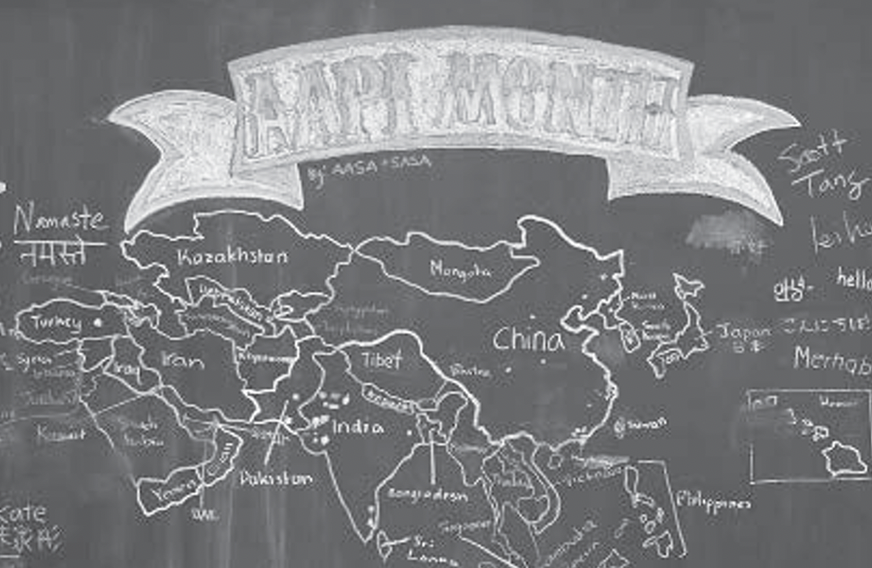To the left of the entrance to the Upper School’s (US) Almy Library is a colorful, full-sized map of Asian and Pacific Islander countries and regions, signed by various Asian-identifying students in the US community. In a collaborative effort between the Asian American Student Association (AASA) and the South Asian Student Association (SASA), affinity group members designed and created a mural celebrating Asian American Pacific Islander (AAPI) Month. Both groups agreed on designing the mural to be a map of Asian countries and aimed to create public art that celebrated AAPI heritage, they said.
Krishna Patel ’25, a member of the SASA, said that the map was the product of various ideas from people from many different backgrounds.
“We had a collaborative meeting between AASA and SASA, and we started blurting out all the ideas that were in our heads. Originally, we started with the idea of just putting a big sign that said AAPI outside of the library, but then someone suggested that we should put a list of all the AAPI countries. I said that it might be hard to do that though, so the idea of a map came after that since it’s more visually appealing than just a list.”
When choosing the design of the map, the AASA and SASA hoped to properly represent all the countries and identities of the AAPI community, she said.
“Originally, we researched what map to choose, and we didn’t want to just do a map of Asia because there are Pacific islands that aren’t in a map of Asia but are still represented by the month. So, we did some research and found a map that properly encapsulates all of those regions. We also wanted to make sure to include the Middle East, since a lot of people don’t realize that it’s also represented by AAPI month. Having a map represent all of this helps people visually understand the many different countries that identify as Asian.”
The creation of the map involved the hard work of many members of the US community during a Friday CAB block, Krishna said.
“On Friday the 12th during CAB, we sent out an email to What’s Happening, inviting members of the US community who identify as AAPI people to contribute their name and a dot representing the location of their heritage on the map. We weren’t sure whether people would show up because everyone usually goes home during Friday CABs, but there was a big turnout. Everyone wrote down their names and had a good time.”
Allison Wang ’25, a member of the AASA, aided in the process of designing and creating the map.
“In the beginning, AASA and SASA had a group meeting to discuss ideas and figure out who would work on the map and when,” she said. “After that, a couple of people in both SASA and AASA worked together to complete the map.”
Both affinity groups hoped to create a mural that represents the AAPI community and the many different cultures within it, she said.
“We just wanted to create a design that represented everyone in the AAPI community,” she said. “We hoped that by creating a map that people could write their names on, students and teachers would be able to get an understanding of how diverse the countries celebrated during AAPI month are.”
The map also allows AAPI students to voice their individual identities, as many signed their names next to the map in both English and the language of their Asian heritage, Allison said.
“Our main goal when creating the map was to let the students at BB&N have a chance to show their pride in being part of the AAPI community,” she said. “We also wanted to educate other students and teachers about what AAPI means, along with what counties and regions are included.”
After the map was finished, some members of the US community made changes to the map without the consent of the creators, changing the names of countries and regions. While the map originally marked both Israel and Palestine, these titles were erased and crossed out at different times. To resolve the issue, the creators of the map rewrote the titles of Israel and Palestine for the purpose of representing both cultures, they said.
Jewish Cultural Club (JCC) CoPresident Kobi Balsam ’24 said that it is important to make sure that the various voices within the US community are represented.
“I think that the best way to solve the issue is to talk with both communities and see in what way can everybody be represented and everybody be happy,” he said. “The best way for everybody to feel included and represented is that everybody speaks up, for themselves and for others. If someone or a group isn’t properly represented, I think that speaking up for themselves is the best way to have their voices heard and valued.”
Amplify Muslim Voices leader Aleeza Riaz ’25 also said that it is important for people to respect each other’s opinions and values.
“Though I wasn’t personally hurt by the situation, we need to respect our peers and treat them kindly. Conversations around these issues should be grounded in respect, as everyone has a right to their own identity.”




